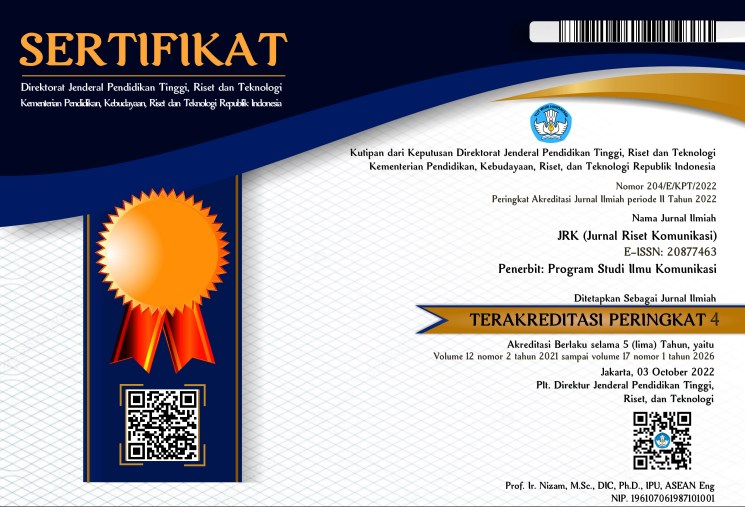Dekonstruksi Standar Kecantikan Kecerdasan Buatan dalam Kampanye Dove The Code
Abstract
Penelitian ini mengkaji bagaimana kampanye The Code dari Dove mendekonstruksi standar kecantikan yang dibentuk oleh kecerdasan buatan dalam ruang digital kontemporer. Tujuan penelitian adalah menganalisis strategi visual dan naratif yang digunakan Dove untuk menantang ideal kecantikan normatif yang diperkuat oleh sistem AI. Penelitian menggunakan pendekatan kualitatif dengan metode analisis semiotika Roland Barthes yang meliputi tiga level analisis yaitu denotatif, konotatif, dan mitologis terhadap video kampanye berdurasi 2 menit. Hasil penelitian menunjukkan bahwa Dove menggunakan empat strategi dekonstruksi utama yaitu kontras visual parodi yang mengekspos absurditas citra ideal AI, komitmen eksplisit anti AI sebagai penolakan dominasi teknologi dalam produksi visual, Real Beauty Prompt Playbook sebagai pedoman inklusif untuk pengguna AI, dan integrasi elemen tekstual musikal yang menguatkan pesan kampanye. Analisis semiotika mengungkap bahwa kampanye ini berhasil mendekonstruksi mitos kecantikan digital dengan menampilkan kontras antara hasil AI yang homogen dengan representasi perempuan beragam. Strategi-strategi tersebut memunculkan kritik terhadap bias algoritma dan data dalam sistem AI yang memperkuat standar kecantikan sempit serta membuka ruang bagi representasi yang lebih otentik. Penelitian menegaskan bahwa kampanye The Code merupakan intervensi kreatif dalam wacana kecantikan digital, namun transformasi sistemik membutuhkan kolaborasi lintas sektor, regulasi etis teknologi, dan peningkatan literasi algoritma masyarakat.
Full Text:
196-216 PDF (Indonesian)References
Adams, P., & Reporter, S. (2024). Dove pledges to not use AI models in lieu of real women in its advertising.
Agrawal, A., Gupta, G., Agrawal, A., & Gupta, H. (2025). Evaluating diversity and stereotypes amongst AI generated representations of healthcare providers. Frontiers in Digital Health, 7. https://doi.org/10.3389/fdgth.2025.1537907
Albert, S. L., Massar, R. E., Cassidy, O., Fennelly, K., Jay, M., Massey, P. M., & Bragg, M. A. (2024). Body Positivity, Physical Health, and Emotional Well-Being Discourse on Social Media: Content Analysis of Lizzo’s Instagram. JMIR Formative Research, 8. https://doi.org/10.2196/60541
AlDahoul, N., Rahwan, T., & Zaki, Y. (2025). AI-generated faces influence gender stereotypes and racial homogenization. Scientific Reports, 15(1), 14449. https://doi.org/10.1038/s41598-025-99623-3
Barthes, R. (1972). Mythologies. https://archive.org/details/mythologies00bart_0.
Bianchi, A. , S. H. & Team. (2023). Bias in AI image generation and representation. Stanford Human-Centered AI.
Cheong, Y. , S. M. , & A. R. (2024). Professions, gender, and race in DALL·E Mini: A critical audit of occupational representations in generative AI.
Cowles, E., Guest, E., & Slater, A. (2023). Imagery versus captions: The effect of body positive Instagram content on young women’s mood and body image. Body Image, 44, 120–130. https://doi.org/10.1016/j.bodyim.2022.12.004
Derrida, J. (1978). Writing and Difference. University of Chicago Press.
Dinata, R. I., & Pratama, M. (2024). Hubungan antara Social Comparison dengan Body Image Dewasa awal Pengguna Media Sosial Tiktok. https://doi.org/10.38035/rrj.v4i3
Faisal, R., Rahman, F., Efendi, S., Sosrohadi, S., Sachiya, F., & Pratama Aditya Mochammad, T. (2025). Analysis of Signs on Online ads: Roland Barthes’ Perspectives. www.ijassjournal.com
Foster, J., & Pettinicchio, D. (2025). “This is real beauty”: pushing the boundaries of aesthetic citizenship online. Critical Studies in Media Communication. https://doi.org/10.1080/15295036.2025.2463409
Gill Rosalind. (2007). Postfeminist media culture: Elements of a sensibility. European Journal of Cultural Studies, 10, 147–166. https://doi.org/10.1177/1367549407075898
Harriger, J. A., Wick, M. R., Sherline, C. M., & Kunz, A. L. (2023). The body positivity movement is not all that positive on TikTok: A content analysis of body positive TikTok videos. Body Image, 46, 256–264. https://doi.org/10.1016/j.bodyim.2023.06.003
Kenig, N., Monton Echeverria, J., & Muntaner Vives, A. (2023). Human Beauty according to Artificial Intelligence. Plastic and Reconstructive Surgery - Global Open, 11(7), E5153. https://doi.org/10.1097/GOX.0000000000005153
Khan, U., Kim, S., Choi, S., & Labroo, A. (2024). Diversity Representations in Advertising: Enhancing Variety Perceptions and Brand Outcomes. Journal of Consumer Research. https://doi.org/10.1093/jcr/ucae060
Konings, F., Vranken, I., Cingel, D., Vandenbosch, L., & De Lenne, O. (2024). Are Diverse Models Really Non-idealized? Investigating Body Positivity Public Feed Posts of Fashion-and Beauty Brands on Instagram.
Levine, M. P., & Murnen, S. K. (2009). “Everybody knows that mass media are/are not [pick one] a cause of eating disorders”: A critical review of evidence for a causal link between media, negative body image, and disordered eating in females. Journal of Social and Clinical Psychology, 28(1), 9–42. https://doi.org/10.1521/jscp.2009.28.1.9
Lisa Marie Sagara. (2024). Dove Says It’ll Never Use AI on Women in Its Advertisements. https://petapixel.com/2024/04/10/dove-says-itll-never-use-ai
Locke, L. G., & Hodgdon, G. (2024). Gender bias in visual generative artificial intelligence systems and the socialization of AI. AI and Society. https://doi.org/10.1007/s00146-024-02129-1
Merino, M., Tornero-Aguilera, J. F., Rubio-Zarapuz, A., Villanueva-Tobaldo, C. V., Martín-Rodríguez, A., & Clemente-Suárez, V. J. (2024). Body Perceptions and Psychological Well-Being: A Review of the Impact of Social Media and Physical Measurements on Self-Esteem and Mental Health with a Focus on Body Image Satisfaction and Its Relationship with Cultural and Gender Factors. In Healthcare (Switzerland) (Vol. 12, Issue 14). Multidisciplinary Digital Publishing Institute (MDPI). https://doi.org/10.3390/healthcare12141396
Mittelstadt, B. D., Allo, P., Taddeo, M., Wachter, S., & Floridi, L. (2016). The ethics of algorithms: Mapping the debate. Big Data and Society, 3(2). https://doi.org/10.1177/2053951716679679
Needle. (2023, December). Dove Real Beauty Campaign: How Dove Reinvented Its Brand. HubSpot Blog. https://blog.hubspot.com/marketing/dove-real-beauty-campaign
Nelson, S. L., Harriger, J. A., Miller-Perrin, C., & Rouse, S. V. (2022). The effects of body-positive Instagram posts on body image in adult women. Body Image, 42, 338–346. https://doi.org/10.1016/j.bodyim.2022.07.013
OpenAI. (2023). DALL·E updates and improvements: Addressing representation bias. Https://Openai.Com/Dall-e.
Ozimek, P., Lainas, S., Bierhoff, H. W., & Rohmann, E. (2023). How photo editing in social media shapes self-perceived attractiveness and self-esteem via self-objectification and physical appearance comparisons. BMC Psychology, 11(1). https://doi.org/10.1186/s40359-023-01143-0
Özkan, F. N. (2025). Unrealistic Beauty Ideals: Artificial Intelligence and Consumers’ Self-Image Perceptions. In Consumer, Marketing, AI: Dark Sides and Ethics. Özgür Yayınları. https://doi.org/10.58830/ozgur.pub710.c3031
Perloff, R. M. (2014). Social Media E,ects on Young Women’s Body Image Concerns: Theoretical Perspectives and an Agenda for Research Sex Roles. https://doi.org/10.1007/s11199-014-0384-6
Putri, M. T., Kn, J., Handok, D., Jakarta, U. M., Dahlan, J. K. H. A., Cireundeu, K., Ciputat, T., & Selatan, K. T. (2023). Analisis Semiotika Perbandingan Antara Logo Halal MUI Dengan Logo Halal Baru. Journal on Education, 06(01), 7825–7835.
Rai, J. K. (2023). Narrating the Beauty Myth of Feminine Body Aesthetics in Classic Nepali Songs. JODEM: Journal of Language and Literature, 14(1), 65–76. https://doi.org/10.3126/jodem.v14i1.57568
Rodgers, R. F., Laveway, K., Campos, P., & de Carvalho, P. H. B. (2023). Body image as a global mental health concern. Cambridge Prisms: Global Mental Health, 10. https://doi.org/10.1017/gmh.2023.2
Scalvini, M. (2024). Empathy and ethics in brand activism: Balancing engagement and responsibility. New Media and Society. https://doi.org/10.1177/14614448241278344
Skilton & Cardinal. (2024). Reflexive Prompt Engineering A Framework for Responsible Prompt Engineering and Interaction Design.
Sobey, A. (2025). The thinness of GenAI: body size in relation to the construction of the normate through GenAI image models. AI and Ethics. https://doi.org/10.1007/s43681-025-00684-x
Tanca, J. T. (2024). Resistance Against Beauty Standards Stereotypes and Representation of Women’s Beauty Through BLP Beauty Advertisement. PERSPEKTIF, 13(1), 123–134. https://doi.org/10.31289/perspektif.v13i1.10594
Tufail, R., Shahwani, A. M., Khan, W., & Badar, Y. (2024). Examining the Impact of AI-Generated Content on Self-Esteem and Body Image Through Social Comparison. Bulletin of Business and Economics (BBE), 13(3), 413–421. https://doi.org/10.61506/01.00514
UNESCO. (2024). Generative AI UNESCO study reveals alarming evidence of regressive gender stereotypes. www.unesco.org
Unilever. (2024, April 23). 20 years on: Dove and the future of Real Beauty.
Wahyuni, I., & Mubarok, A. (2023). Analisis Semiotika: Roland Barthes Dalam Iklan K-Natural White Brightening Body Wash Versi Agatha Chelsea (Vol. 7, Issue 2).
Washington Post. (2023). AI’s vision of beauty still favors light skin and youth. The Washington Post. https://www.washingtonpost.com/
Yang, Y. (2025). Racial bias in AI-generated images. AI and Society. https://doi.org/10.1007/s00146-025-02282-1
DOI: http://dx.doi.org/10.62870/jrk.v1i1.33030
Refbacks
- There are currently no refbacks.









